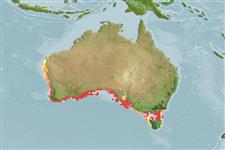>
Syngnathiformes (Pipefishes and seahorses) >
Syngnathidae (Pipefishes and seahorses) > Syngnathinae
Etymology: Hippocampus: Greek, ippos = horse + Greek,kampe = curvature (Ref. 45335).
More on author: Peters.
Environment: milieu / climate zone / depth range / distribution range
Ecologia
marino demersale; non migratori; distribuzione batimetrica 0 - 15 m (Ref. 52034). Temperate; 21°S - 43°S
Indo-Pacific: endemic to south west Australia.
Length at first maturity / Size / Peso / Age
Maturity: Lm 4.6 range ? - ? cm
Max length : 15.0 cm TL maschio/sesso non determinato; (Ref. 9002); common length : 12.0 cm TL maschio/sesso non determinato; (Ref. 9002)
Short description
Chiavi di identificazione | Morfologia | Morfometria
Spine dorsali (totale) : 0; Raggi dorsali molli (totale) : 19 - 23; Spine anali: 0; Raggi anali molli: 4.
Adults inhabit inshore waters (Ref. 7300). Occur in small to large aggregations in weed patches attached to rocks on sand, mostly in Sargassum weeds (Ref. 9002). Ovoviviparous (Ref. 205). The male carries the eggs in a brood pouch which is found under the tail (Ref. 205). Minimum depth reported taken from Ref. 128812.
Male incubates the eggs in a pouch. Produces 50 to 100 young in single or combined brood from several females (Ref. 9002).
Lourie, S.A., R.A. Pollom and S.J. Foster, 2016. A global revision of the seahorses Hippocampus Rafinesque 1810 (Actinopterygii: Syngnathiformes): taxonomy and biogeography with recommendations for further research. Zootaxa 4146(1):1-66. (Ref. 115213)
IUCN Red List Status (Ref. 130435: Version 2024-2)
Threat to humans
Harmless
Human uses
Pesca: di nessun interesse
Strumenti
Special reports
Download XML
Fonti Internet
Estimates based on models
Preferred temperature (Ref.
123201): 15 - 18.4, mean 16.9 °C (based on 188 cells).
Phylogenetic diversity index (Ref.
82804): PD
50 = 0.5000 [Uniqueness, from 0.5 = low to 2.0 = high].
Bayesian length-weight: a=0.00447 (0.00175 - 0.01142), b=2.99 (2.77 - 3.21), in cm total length, based on LWR estimates for this (Sub)family-body shape (Ref.
93245).
Trophic level (Ref.
69278): 3.5 ±0.48 se; based on food items.
Resilienza (Ref.
120179): Medio, tempo minimo di raddoppiamento della popolazione 1.4 - 4.4 anni (Fec=50-100).
Fishing Vulnerability (Ref.
59153): Low vulnerability (10 of 100).
